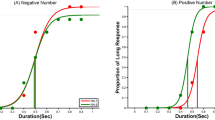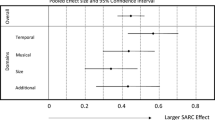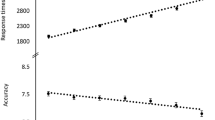Abstract
Space, time, and number are among fundamental aspects of behavior and reasoning about the environment. Recent studies have shown that these dimensions highly interact with each other. To explain such interaction, two theories have been proposed: A Theory of Magnitude (ATOM), which posits the existence of a common magnitude system, and Conceptual Metaphor Theory (CMT), which proposes abstract domains such as time and number are mapped through more concrete domains such as space. The present study investigates the interaction of number, time and space in a single experimental paradigm using a temporal reproduction task with a visuospatial component. We also investigated whether mathematical education and continuous involvement with calculations and numbers change the processing precision related to number, time, and space. Two groups of students in mathematics (n = 28) and Persian literature (n = 28) participated in a time reproduction task. The stimuli included Arabic numbers 1, 2, 8, and 9, which were presented to the participants over short (300, 400, 500 ms) and long durations (1000, 1100, 1200 ms) on both sides (left and right) of the monitor. The interaction effect of spatialـnumerical and temporal-numerical was found to be significant. There was no overall time–space interaction, but the triple interaction effect between number, time, and space was significant suggesting the existence of a common representational system. This main result was slightly in line with recent proposed theories. Furthermore, the results showed that the main effect of group was not significant. In addition, we found that among the three factors (number, time, and space) the effect of number is more prominent, i.e., when number disappeared the interaction effect was not observed. The results also suggest that the nature of interactions between these factors is not influenced by cognitive and educational factors. The findings of the study are finally discussed in terms of symmetrical or asymmetrical cross-dimensional influences within the frameworks of ATOM and CMT theories.



Similar content being viewed by others
References
Bonato M, Zorzi M, Umiltà C (2012) When time is space: evidence for a mental time line. Neurosci Biobehav Rev 36(10):2257–2273
Boroditsky L (2000) Metaphoric structuring: understanding time through spatial metaphors. Cognition 75(1):1–28
Bottini R, Casasanto D (2010) Implicit spatial length modulates time estimates, but not vice versa. In: International conference on spatial cognition, Springer
Brannon EM, Roitman JD (2003) Nonverbal representations of time and number in animals and human infants
Brown SW (1985) Time perception and attention: the effects of prospective versus retrospective paradigms and task demands on perceived duration. Percept Psychophys 38(2):115–124
Brown SW (1997) Attentional resources in timing: interference effects in concurrent temporal and nontemporal working memory tasks. Percept Psychophys 59(7):1118–1140
Brozzoli C, Ishihara M, Göbel SM, Salemme R, Rossetti Y, Farnè A (2008) Touch perception reveals the dominance of spatial over digital representation of numbers. Proc Natl Acad Sci 105(14):5644–5648
Bueti D, Walsh V (2010) Memory for time distinguishes between perception and action. Perception 39(1):81–90
Bueti D, Bahrami B, Walsh V (2008a) Sensory and association cortex in time perception. J Cognit Neurosci 20(6):1054–1062
Bueti D, Walsh V, Frith C, Rees G (2008b) Different brain circuits underlie time processing for action and perception. J Cognit Neurosci 20:204–214
Buhusi CV, Meck WH (2005) What makes us tick? Functional and neural mechanisms of interval timing. Nat Rev Neurosci 6(10):755
Burr DC, Ross J, Binda P, Morrone MC (2011) Saccades compress space, time, and number. Space, time and number in the brain. Elsevier, Amsterdam, pp 175–186
Cantlon JF, Platt ML, Brannon EM (2009) Beyond the number domain. Trends Cognit Sci 13(2):83–91
Cappelletti M, Freeman ED, Cipolotti L (2009) Dissociations and interactions between time, numerosity and space processing. Neuropsychologia 47(13):2732–2748
Cappelletti M, Freeman ED, Cipolotti L (2011) Numbers and time doubly dissociate. Neuropsychologia 49(11):3078–3092
Casarotti M, Michielin M, Zorzi M, Umiltà C (2007) Temporal order judgment reveals how number magnitude affects visuospatial attention. Cognition 102(1):101–117
Casasanto D, Boroditsky L (2008) Time in the mind: using space to think about time. Cognition 106(2):579–593
Casasanto D, Fotakopoulou O, Boroditsky L (2010) Space and time in the child’s mind: evidence for a cross-dimensional asymmetry. Cognit Sci 34(3):387–405
Chang AY-C, Tzeng OJ, Hung DL, Wu DH (2011) Big time is not always long: numerical magnitude automatically affects time reproduction. Psychol Sci 22(12):1567–1573
Conson M, Cinque F, Barbarulo AM, Trojano L (2008) A common processing system for duration, order and spatial information: evidence from a time estimation task. Exp Brain Res 187(2):267–274
Coull JT, Charras P, Donadieu M, Droit-Volet S, Vidal F (2015) SMA selectively codes the active accumulation of temporal, not spatial, magnitude. J Cognit Neurosci 27(11):2281–2298
Dehaene S (2011) The number sense: how the mind creates mathematics, OUP USA
Dehaene S, Bossini S, Giraux P (1993) The mental representation of parity and number magnitude. J Exp Psychol Gen 122(3):371
Dehaene S, Dehaene-Lambertz G, Cohen L (1998) Abstract representations of numbers in the animal and human brain. Trends Neurosci 21(8):355–361
DeLong AJ (1981) Phenomenological space-time: toward an experiential relativity. Science 213(4508):681–683
Dormal Andres VM, Pesenti M (2008) Dissociation of numerosity and duration processing in the left intraparietal sulcus: a transcranial magnetic stimulation study. Cortex 44(4):462–469
Dormal V, Dormal G, Joassin F, Pesenti M (2012a) A common right fronto-parietal network for numerosity and duration processing: an fMRI study. Hum Brain Mapp 33(6):1490–1501
Dormal V, Grade S, Mormont E, Pesenti M (2012b) Dissociation between numerosity and duration processing in aging and early Parkinson’s disease. Neuropsychologia 50(9):2365–2370
Droit-Volet S (2010) Speeding up a master clock common to time, number and length? Behav Proc 85(2):126–134
Fabbri M, Cancellieri J, Natale V (2012) The a theory of magnitude (ATOM) model in temporal perception and reproduction tasks. Acta Physiol (Oxf) 139(1):111–123
Fabbri M, Cellini N, Martoni M, Tonetti L, Natale V (2013a) The mechanisms of space-time association: comparing motor and perceptual contributions in time reproduction. Cognit Science 37(7):1228–1250
Fabbri M, Cellini N, Martoni M, Tonetti L, Natale V (2013b) Perceptual and motor congruency effects in time–space association. Atten Percept Psychophys 75(8):1840–1851
Feigenson L (2007) The equality of quantity. Trends Cognit Sci 11(5):185–187
Fischer MH, Mills RA, Shaki S (2010) How to cook a SNARC: number placement in text rapidly changes spatial-numerical associations. Brain Cognit 72(3):333–336
Fuhrman O, Boroditsky L (2007) Mental time-lines follow writing direction: comparing english and hebrew speakers. In: Proceedings of the annual meeting of the cognitive science society
Gallistel CR, Gelman R (2000) Non-verbal numerical cognition: from reals to integers. Trends Cognit Sci 4(2):59–65
Galton F (1880) Visualised numerals. Nature Publishing Group, Berlin
Gazzaniga M (2000) The new cognitive neurosciences. MIT Press, Cambridge
Gevers W, Lammertyn J, Notebaert W, Verguts T, Fias W (2006) Automatic response activation of implicit spatial information: evidence from the SNARC effect. Acta Physiol (Oxf) 122(3):221–233
Gibbs RW Jr (2005) Embodiment and cognitive science. Cambridge University Press, Cambridge
Gijssels T, Bottini R, Rueschemeyer S-A, Casasanto D (2013) Space and time in the parietal cortex: fMRI evidence for a meural asymmetry. In: The 35th annual meeting of the cognitive science society (CogSci 2013), Cognitive Science Society
Grondin S (2005) Overloading temporal memory. J Exp Psychol Hum Percept Perform 31(5):869–879
Gunderson EA, Ramirez G, Beilock SL, Levine SC (2012) The relation between spatial skill and early number knowledge: the role of the linear number line. Dev Psychol 48(5):1229
Halberda J, Mazzocco MM, Feigenson L (2008) Individual differences in non-verbal number acuity correlate with maths achievement. Nature 455(7213):665
Heinemann A, Pfister R, Janczyk M (2013) Manipulating number generation: loud + long = large? Conscious Cognit 22(4):1332–1339
Herrera A, Macizo P, Semenza C (2008) The role of working memory in the association between number magnitude and space. Acta Physiol (Oxf) 128(2):225–237
Hinton SC, Harrington DL, Binder JR, Durgerian S, Rao SM (2004) Neural systems supporting timing and chronometric counting: an FMRI study. Cogn Brain Res 21(2):183–192
Holmes KJ (2012) Orienting numbers in mental space: horizontal organization trumps vertical. Q J Exp Psychol 65(6):1044–1051
Ishihara M, Keller PE, Rossetti Y, Prinz W (2008) Horizontal spatial representations of time: evidence for the STEARC effect. Cortex 44(4):454–461
Jaffe K, Mascitti G, Seguias D (2012) Gender differences in time perception and its relation with academic performance: non-linear dynamics in the formation of cognitive systems. arXiv preprint arXiv:1203.3954
Jones LA, Wearden J (2004) Double standards: memory loading in temporal reference memory. Q J Exp Psychol Sect B 57(1):55–77
Kiesel A, Vierck E (2009) SNARC-like congruency based on number magnitude and response duration. J Exp Psychol Learn Mem Cognit 35(1):275
Klapproth F (2009) Single-modality memory mixing in temporal generalization: an effect due to instructional ambiguity. NeuroQuantology 7(1)
Kramer P, Bressan P, Grassi M (2011) Time estimation predicts mathematical intelligence. PLoS ONE 6(12):e28621
Lakoff G, Johnson M (2008) Metaphors we live by, University of Chicago press
Lakoff G, Johnson M (1999) Philosophy in the flesh. Basic books, New york
Lakoff G, Núñez RE (2000) Where mathematics comes from: how the embodied mind brings mathematics into being. AMC 10(12):720–733
Lambrechts A, Walsh V, van Wassenhove V (2013) Evidence accumulation in the magnitude system. PLoS ONE 8(12):e82122
LeFevre JA, Fast L, Skwarchuk SL, Smith-Chant BL, Bisanz J, Kamawar D, Penner-Wilger M (2010) Pathways to mathematics: longitudinal predictors of performance. Child Dev 81(6):1753–1767
Lejeune H, Wearden JH (2009) Vierordt’s the experimental study of the time sense (1868) and its legacy. Eur J Cognit Psychol 21(6):941–960
Leon MI, Shadlen MN (2003) Representation of time by neurons in the posterior parietal cortex of the macaque. Neuron 38(2):317–327
Lewis PA, Miall RC (2006) Remembering the time: a continuous clock. Trends Cognit Sci 10(9):401–406
Liu X, Wang H, Corbly CR, Zhang J, Joseph JE (2006) The involvement of the inferior parietal cortex in the numerical Stroop effect and the distance effect in a two-digit number comparison task. J Cognit Neurosci 18(9):1518–1530
Lourenco SF, Longo MR (2011) Origins and development of generalized magnitude representation. Space time and number in the brain. Elsevier, Amsterdam, pp 225–244
Lu A, Hodges B, Zhang J, Zhang JX (2009) Contextual effects on number–time interaction. Cognition 113(1):117–122
Marghetis T, Youngstrom K (2014) Pierced by the number line: integers are associated with back-to-front sagittal space. In: Proceedings of the annual meeting of the cognitive science society
Martin B, Wiener M, van Wassenhove V (2017) A Bayesian perspective on accumulation in the magnitude system. Sci Rep 7(1):630
Matlock T, Holmes KJ, Srinivasan M, Ramscar M (2011) Even abstract motion influences the understanding of time. Metaphor Symb 26(4):260–271
Meck WH, Church RM (1983) A mode control model of counting and timing processes. J Exp Psychol Anim Behav Process 9(3):320
Merritt DJ, Casasanto D, Brannon EM (2010) Do monkeys think in metaphors? Representations of space and time in monkeys and humans. Cognition 117(2):191–202
Moyer RS, Landauer TK (1967) Time required for judgements of numerical inequality. Nature 215(5109):1519–1520
Müller D, Schwarz W (2008) “1-2-3”: is there a temporal number line? Evidence from a serial comparison task. Exp Psychol 55(3):143–150
Nazari MA, Sabouri Moghaddam H, Poursharifi H, Bayrami M, Jahan A (2015) Interaction of numbers and spatial attention in Iranian people. J Res Rehabilit Sci [Persian] 10(6):819–832
Nazari MA, Caria A, Soltanlou M (2017) Time for action versus action in time: time estimation differs between motor preparation and execution. J Cognit Psychol 29(2):129–136
Nishida SY, Johnston A (2002) Marker correspondence, not processing latency, determines temporal binding of visual attributes. Curr Biol 12(5):359–368
Odic D (2018) Children’s intuitive sense of number develops independently of their perception of area, density, length, and time. Dev Sci 21(2):e12533
Ogden RS, Wearden J, Jones LA (2008) The remembrance of times past: interference in temporal reference memory. J Exp Psychol Hum Percept Perform 34(6):1524
Oliveri M, Vicario CM, Salerno S, Koch G, Turriziani P, Mangano R, Chillemi G, Caltagirone C (2008) Perceiving numbers alters time perception. Neurosci Lett 438(3):308–311
Pecher D, Boot I (2011) Numbers in space: differences between concrete and abstract situations. Front Psychol 2:121
Perbal S, Pouthas V, Van der Linden M (2000) Time estimation and amnesia: a case study. Neurocase 6(4):347–356
Piazza M, Facoetti A, Trussardi AN, Berteletti I, Conte S, Lucangeli D, Dehaene S, Zorzi M (2010) Developmental trajectory of number acuity reveals a severe impairment in developmental dyscalculia. Cognition 116(1):33–41
Pouthas V, Perbal S (2004) Time perception depends on accurate clock mechanisms as well as unimpaired attention and memory processes. Acta Neurobiol Exp 64(3):367–386
Schneider M, Grabner RH, Paetsch J (2009) Mental number line, number line estimation, and mathematical achievement: their interrelations in grades 5 and 6. J Educ Psychol 101(2):359
Sell AJ, Kaschak MP (2012) The comprehension of sentences involving quantity information affects responses on the up–down axis. Psychon Bull Rev 19(4):708–714
Shaki S, Fischer MH (2008) Reading space into numbers: a cross-linguistic comparison of the SNARC effect. Cognition 108(2):590–599
Shaki S, Fischer MH, Petrusic WM (2009) Reading habits for both words and numbers contribute to the SNARC effect. Psychon Bull Rev 16(2):328–331
Skagerlund K, Träff U (2014) Development of magnitude processing in children with developmental dyscalculia: space, time, and number. Front Psychol 5:675
Turconi E, Campbell JI, Seron X (2006) Numerical order and quantity processing in number comparison. Cognition 98(3):273–285
Vicario CM, Caltagirone C, Oliveri M (2007) Optokinetic stimulation affects temporal estimation in healthy humans. Brain Cogn 64(1):68–73
Vicario CM, Pecoraro P, Turriziani P, Koch G, Caltagirone C, Oliveri M (2008) Relativistic compression and expansion of experiential time in the left and right space. PLoS ONE 3(3):e1716
Vicario CM, Pavone EF, Martino D, Fuggetta G (2011) Lateral head turning affects temporal memory. Percept Mot Skills 113(1):3–10
Vicario CM, Rappo G, Pepi A, Pavan A, Martino D (2012) Temporal abnormalities in children with developmental dyscalculia. Dev Neuropsychol 37(7):636–652
Walsh V (2003) A theory of magnitude: common cortical metrics of time, space and quantity. Trends Cognit Sci 7(11):483–488
Walsh V (2015) A theory of magnitude: the parts that sum to number. In: The oxford handbook of numerical cognition, pp 552–565
Winter B, Perlman M, Matlock T (2013) Using space to talk and gesture about numbers: evidence from the TV News Archive. Gesture 13(3):377–408
Xuan B, Zhang D, He S, Chen X (2007) Larger stimuli are judged to last longer. J Vis 7(10):2–2
Yamamoto K, Sasaki K, Watanabe K (2016) The number–time interaction depends on relative magnitude in the suprasecond range. Cogn Process 17(1):59–65
Zebian S (2005) Linkages between number concepts, spatial thinking, and directionality of writing: the SNARC effect and the reverse SNARC effect in English and Arabic monoliterates, biliterates, and illiterate Arabic speakers. J Cognit Culture 5(1):165–190
Zhang X, Koponen T, Räsänen P, Aunola K, Lerkkanen MK, Nurmi JE (2014) Linguistic and spatial skills predict early arithmetic development via counting sequence knowledge. Child Dev 85(3):1091–1107
Acknowledgements
The authors would like to thank Ali Jahan for assistance in task creation and all participants who took part in the experiment.
Funding
This research did not receive any specific grant from funding agencies in the public, commercial, or not-for-profit sectors. This paper is extracted from MA dissertation of the first author.
Author information
Authors and Affiliations
Corresponding author
Additional information
Publisher's Note
Springer Nature remains neutral with regard to jurisdictional claims in published maps and institutional affiliations.
Handling editor: Martin H. Fischer (University of Potsdam).
Reviewers: Marco Fabbri (University of Campania Luigi Vanvitelli) and the handling editor.
Rights and permissions
About this article
Cite this article
Nourouzi Mehlabani, S., Sabaghypour, S. & Nazari, M.A. Number is special: time, space, and number interact in a temporal reproduction task. Cogn Process 21, 449–459 (2020). https://doi.org/10.1007/s10339-020-00968-6
Received:
Accepted:
Published:
Issue Date:
DOI: https://doi.org/10.1007/s10339-020-00968-6




